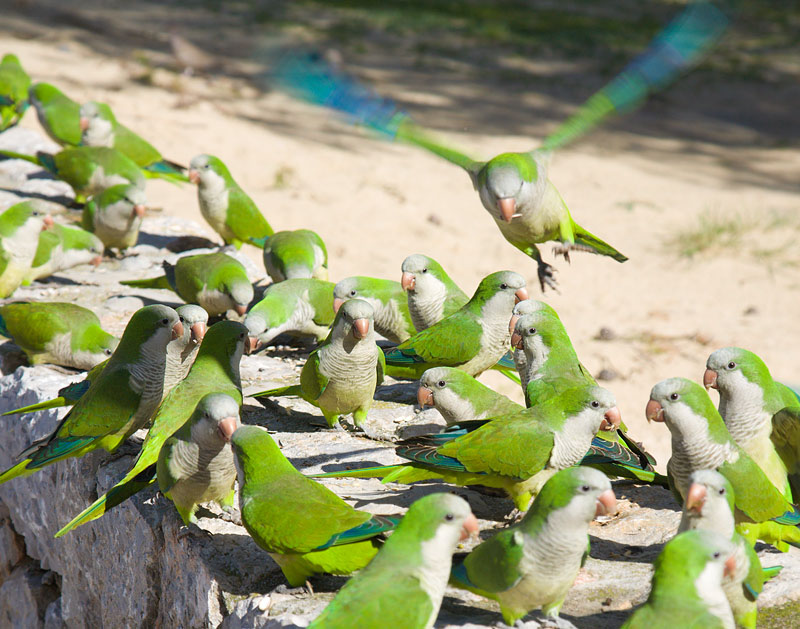Pecking order for birdbrains
Monk parakeets, like humans, use complex thinking to understand where they stand in their group’s social order
Shira Polan • October 22, 2015

Although native to the forests of South America, Monk parakeets have been known to form feral colonies in urban areas like New York City. [Image Credit: Wikipedia Commons user Tamara K]
Navigating the perils of complex social groups can be tricky. Ask anyone who’s been through high school — or the monk parakeet. A new study found that when the parrot joins a new social group, it uses logic to figure out its rank in the pecking order. The findings could help explain the evolution of complex societies in social, intelligent animals like parrots.
Monk parakeets are small, lime-green birds that live in enormous apartment-style nests with up to 30 neighbors. These parrots occasionally fight for status, making them useful subjects for Elizabeth Hobson, a behavioral ecologist at the University of Tennessee. She wanted to study how animals determine their social standing in a big society that requires complex social navigation.
Hobson’s study, published last month in PLOS Computational Biology, suggests that the birds rely upon well-developed memory and inferential skills to sort out the intricate network of social status. When a colony is first established, the parakeets carefully observe fights between group mates, keeping track of the winners. They then determine the hierarchy of the colony through a process called inductive reasoning: Parakeet A fights parakeet B, and then observes B fighting C and C fighting D. A then decides how to behave toward D, without ever directly interacting with D. Hobson says this ability requires significant cognitive skill.
To study the parakeets, Hobson established a new group, which she housed in large enclosures shaped like circus tents that she said mimicked their wild habitat. She observed the groups for nearly a month, recording aggressive acts such as knocking each other off their perches and stealing their place. Her team calculated hypothetical hierarchies as if the birds were not following any rules. They then compared these potential rankings with the rankings actually demonstrated by the birds’ behavior. The researchers found that when the birds first formed the group, their rankings reflected random hierarchies.
But once the parakeets had a chance to interact, their behavior changed. After just a week, rather than fighting with parakeets much weaker than themselves, the birds only fought individuals close to their own rank. This demonstrated that the parakeets observed and remembered the outcomes of their groupmates’ fights and determined which individuals were their biggest competition. The birds just below them in ranking posed the strongest threat to their social standing, so those were the parakeets they would pick on.
Hobson says that her methods could be used to expand research in animal social behavior across many different species. “Our approach only requires us to know who’s winning, how many times and over which individuals. A lot of preexisting data exists, so we can go back and look at countless species, from hermit crabs to humans.”
Other scientists have some reservations about the study’s insight into parrot social behavior since the animals were not studied in a natural setting. “I think this study has stronger implications for research methodology than for understanding animal behavior,” says animal behaviorist Alex Thornton at the University of Exeter. “The birds were in a captive environment, so what’s not clear is whether the pattern the authors describe is specific to this individual situation, or is more generalizable.”
Regardless of the study’s generalizability, the findings offer a new way to consider how parrots think about the world around them and where they, as individuals, might fit.
1 Comment
A recent advancement in stem cells culture may help to establish brain models for such researches. Metabolites that dictate the differentiation direction of stem cells were spotted by scientists and with the metabolites, target tissue cells are cultured. May this finding boost the studies in brain activities by assisting the process.